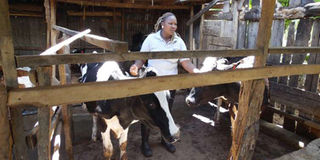How I made my eight cows offer six times more

Andrian Gitonga in her dairy farm in Meru. She collects over 130 litres of milk, which she sells to Nkuene Dairy Co-operative Society at Sh35 a litre. PHOTO | CAROLINE WAMBUI | NATION MEDIA GROUP
What you need to know:
- Adrian Gitonga's journey into farming started three years ago when she took a bank loan of Sh800,000 with which she bought eight Friesian lactating cows from a farmer and three chaff cutter machines.
- She feeds her cows at 5am only, each animal getting 40kg silage, 10kg of napier grass and a percentage of dairy meal depending on the milk production at several intervals during the day.
- An animal should feed 3 per cent of its body weight for dry feeds while 10 per cent for Wet feeds.
- Feed supplements like sunflower cake and napier should not be more that 3ft tall when cut. Cotton seed cake is equally important, depending on the production to improve on the palatability and increase the energy required.
Andrian Gitonga, a 35-year-old accountant, is seated on a wooden bench on her farm named Focus in Nkubu, Meru when we arrive.
Her focus is on hand-written papers in her left hand detailing that morning’s milk records.
Andrian is the proud owner of 30 cows – eight lactating ones, eight heifers, three calves and 11 bulls that she fattens for sale.
In a day, Andrian collects over 130 litres of milk, which she sells to Nkuene Dairy Co-operative Society at Sh35 a litre.
This seems a low feat since some farmers get over 40 litres from each cow a day. But Andrian was not doing this well.
Her journey into farming started three years ago. She took a bank loan of Sh800,000 with which she bought eight Friesian lactating cows from a farmer and three chaff cutter machines.
But even after devoting her mind, body and cash to the venture, one thing gave her sleepless nights - milk production from the eight cows was a measly 20 litres a day, making it impossible for her to repay the loan.
“I realised that I bought the wrong cows because some of them had calved down over three times, information that I was not told. And to make matters worse, the feeds I was giving them mainly comprised of dry maize stalks and napier grass.”
Defeated but not someone to give up, she sought professional advice in 2014 from Policy and Market Options, a local firm supporting farmers in agribusiness through training and advisory.
SUFFICIENT QUALITY FODDER
“I learnt the best dairy practices such as how best to grow fodder and preserve quality silage. I also learnt that for proper feeding, one has to have sufficient quality fodder all-year round,” she says, noting she was determined to make something out of the cows.
Andrian moved from feeding her livestock on wet overgrown napier grass and dry maize stovers to maize silage which she supplemented with Boma Rhodes and dry napier grass.
“I learnt that the wet napier grass I used to feed my cows had little dry matter content yet I thought it was the best from the way it looked. Before you offer that napier, dry it for a day or two in the sun and afterwards cut it into small pieces with a chaff cutter or machete,” she offers.
Andrian also started buying maize when at milking stage and ensiling it into 500kg tube bunkers. She was advised that maize has a high protein content level that could help boost her production.
And the results were nearly instant. “I registered yield increase within the first month. Milk production first went to 50 litres from 20, then shot to 70 litres a day,” she says, noting she later leased six acres at Sh30,000 where she planted maize for ensiling.
In June 2015, however, she bought an acre where she grows maize for ensiling.
Today Andrian, who has made some good money from the cows and is slowly phasing them out, has six bunkers measuring 6 by 11 metres, where she stores an average of 40 tonnes of silage, feeds that lasts her over one-and-a-half years. Her top cow offers 30 litres a day and the least 20.
FEEDS COMPRISE ALL KEY NUTRIENTS
She feeds her cows at 5am only, each animal getting 40kg silage, 10kg of napier grass and a percentage of dairy meal depending on the milk production at several intervals during the day.
“For every three litres of milk produced, I feed a kilo of dairy meal at a ratio that is distributed through the milking hours. That is, if a cow is producing 30 litres, I feed it 10kg of dairy meal; about 3kg after every milking,” she says, noting the cows are milked at 5am, 11am and at 6pm.
David Njoka, a livestock production officer at Imenti South, says an animal should feed 3 per cent of its body weight for dry feeds, with the feeds comprising all the key nutrients.
Wet feeds on the other hand, should be 10 per cent of the body weight.
“Feed supplements like sunflower cake and napier should not be more that 3ft tall when cut. Cotton seed cake is equally important, depending on the production to improve on the palatability and increase the energy required. Other concentrates like maize germ can be incorporated in the silage to enrich it as it is very palatable and digestible.”





